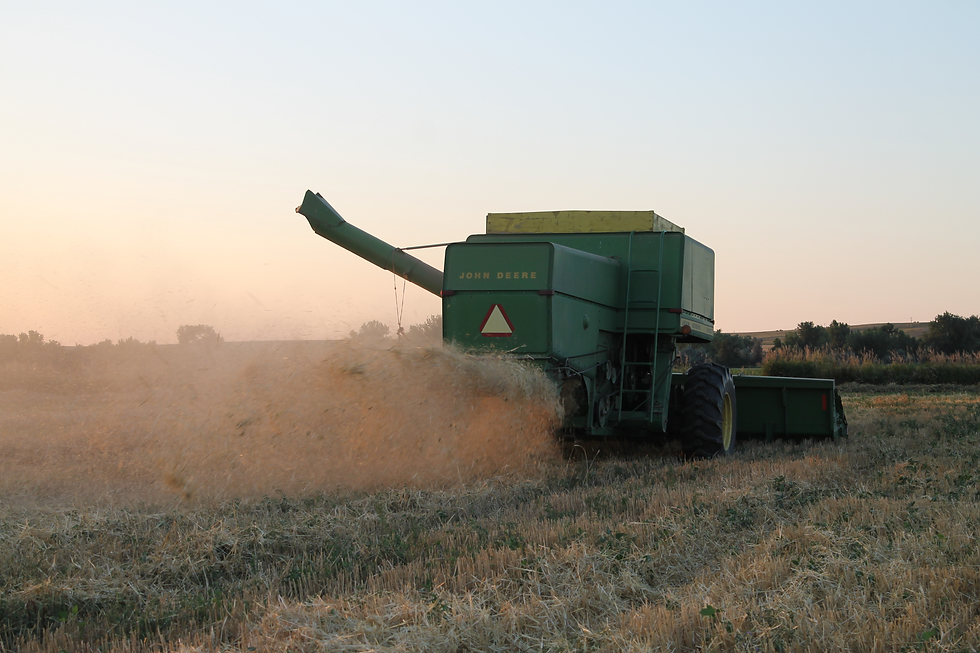Organic Grain Farming: Belle Valley Ancient Grains
- Robin Bacon
- Dec 1, 2023
- 3 min read
“It is vitally important that we can continue to say, with absolute conviction, that organic farming delivers the highest quality, best-tasting food produced.” - Prince Charles

Background In Organics
Making the transition to establishing organic agriculture is a paradigm. For farmers, the transition typically requires small, realistic steps. Farm economics and personal goals influence how fast or far farmers transition. Each small decision makes a difference and advances the system further on the sustainable agriculture continuum. As many grain farmers have shared, the key to moving forward is the will to adopt on-farm practices that make sense, align with each farm's needs, and work with organics agencies and organizations that make sense.
Organic practices require organic seeds, regenerative soil techniques like cover crops, and biodynamic solutions for pest management. Some farmers seek ways to generate revenues from the cover crops to shore up the extra expenses of organic operations management. The anticipated outcome is to listen to farmers share how they identify, better understand, and effectively manage the risks they expect to face in their farm business operation. Applying the concepts and relationships can increase the knowledge of organic practices and technology the farming industry offers.
Belle Valley Ancient Grains

Brian Stambaugh and his family, owners of Belle Valley Ancient Grains, are a sixth-generation farming operation and miller not far from the Black Hills of western South Dakota. Brian is the sixth generation involved in farming or milling in South Dakota - a farmer and mechanical engineer with knowledge of his family history and organic farming applications. Their farm is certified organic, all their grains are chemical-free, and they use crop rotation to build nitrogen in the soil. Belle Valley Ancient Grains rotate alfalfa, beans, and lentils for necessary plant nutrition. Brian and his family run 200 acres, 170 of which are irrigated. However, Brian grew up on a farm just a few miles distant from a dairy operation with Holsteins, a breed originating from the Netherlands. They milked 30-35 cows twice daily and named each one in the milking barn.

After a career that took the family to Colorado and Texas, they missed the farm, so they returned to South Dakota and started growing hay. In 2015, Brian and his family began growing organic grains for people interested in heirloom and heritage agricultural products for their breads, pastries, and cereals. They are fully integrated, 100% farmed, and have the option of stone-milling, which allows the baker to optionally sift the bran from the flour. Stone milling is an age-old process where millers apply composition stones made from granite or basalt to grind their berries. Starting with the Whisper Mill some years back, they have progressed their operations and offer their freshly ground products on Etsy, building a national reach for their milled products. The Stambaughs also sell locally and regionally in retail shops and grocers.
Belle Valley Grains

The Farming & Harvest Approach
Belle Valley implemented a no-till or minimum-till practice, when possible, to build nitrogen and organic matter throughout the soil. If tillage is required, they use a chisel plow and occasionally a moldboard plow to aerate and reduce compaction when rotating crops from wheat to alfalfa or beans. Chisel plowing is more efficient than moldboard plowing, however, does not provide nearly the level of vertical tillage. When planting, they use a 1950s grain planter, or occasionally borrow a modern no-till drill from a neighbor.

Swathing is performed when the farmer cuts the crop, placing it in rows supported by the remaining stubble left over from the cut, and this is the first phase in the Stambaugh's wheat harvesting practices. It allows for weed drying and for moisture levels to adjust in the grain, as everything must be dry for the combine to run correctly. Dry wheat is essential when it comes to using the combine because the machine will separate the grain pant from the plant's tops, loosen the grains, and bounce them into the hopper.

Cleaning the grain requires a seed cleaner, which cleans the chaff, and removes broken seeds through a screening process until fully purified. Belle Valley uses a Clipper air-screen cleaner and Oliver gravity table, rescued from Payette, Idaho. They also purchased, from Great Falls, Montana, a rice de-huller, which adapted well to their grain harvest cleaning process. An optical color sorter provides the final step in cleaning. Once the grain is cleaned, it is stored in totes before final packaging or milling.
Where To Buy Belle Valley Ancient Grains









Comments